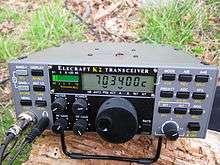Elecraft
| Amateur radio manufacturer | |
| Industry | Amateur radio |
| Founded | 1998 |
| Headquarters | Watsonville, California, U.S. |
| Website | http://www.elecraft.com/ |


Elecraft, Inc. is an American manufacturer of amateur radio ("ham") equipment and kits, based in Watsonville, California. It was founded in 1998 by Wayne Burdick and Eric Swartz.[1] The company's first product was the K2 transceiver, which was first prototyped in October 1997.[2]
The company is most notable for the Elecraft K3 high-performance HF transceiver, a 32-bit DSP based radio covering HF plus the 6-meter VHF band and the 160-meter MF band, introduced in 2008. The reception of the K3 was overwhelmingly positive, with a comprehensive review in QST stating that "The K3, in any of the available configurations, provides a high performance, modular and expandable transceiver that can fill the needs of almost anyone looking for an HF and 6 meter transceiver for home station or portable use".[3] At the time of its introduction, the K3 received the highest Sherwood Engineering ranking of any amateur radio receiver.[4]
Elecraft's product lineup includes a range of QRP CW transceivers, the K2 and K3 all-mode 100W transceiver, KX2 and KX3 portable 160m–2m transceiver, linear power amplifiers, two panadapters and a range of accessories including antenna tuners and signal generators.
Many Elecraft products are available both as kits and as ready-built units. All offer expansion options. One K3 option, the K144XV, adds a 10-watt 2-meter internal transceiver. The KX3 can accommodate a single internal VHF transverter module. The KX3-2M adds the 2-meter band and the KX3-4M adds 4-meter band, both with 2.5-watt RF output. The 2-meter module receives 120-165 MHz, and transmits on the 2-meter amateur radio band. The 4-meter module covers 65–72 MHz. Sensitivity gradually falls off outside the ham bands, though the 2-meter module is capable of receiving 162 MHz weather-band stations and 120 MHz airport tower AM.[5]
The KX3 transceiver is a portable software-defined radio (SDR) transceiver with a full-featured knob-and-button interface. Although it is an SDR transceiver, it does not require a computer connection.[6]
The company's well regarded "K-Line" consists of the K3 transceiver, the KPA500 500W solid-state power amplifier, the KAT500 automatic antenna tuner, and the P3 panadapter.[7] Also the P3SVGA add-on to the P3 to display the panadapter data on a large screen and the W2 HF/VHF/UHF wattmeter are sometimes considered part of the K-Line. Most recently Elecraft has introduced the "KX-Line" consisting of the KX2 and KX3 transceivers, the PX3 panadapter, and the KXPA100 100W power amplifier.[8]
In 2015, Elecraft introduced the K3S Transceiver as a direct replacement for the K3 Transceiver. The K3S is a redesign of the K3 with new or upgraded features, most of which can be back fitted to an older K3.[9]
The K3S is ranked second in overall performance by Sherwood Engineering.
In 2017 Elecraft introduced the KPA1500, a 1500 watt (full legal limit) amplifier. The KPA1500 covers the 160 through 6 meter bands. Its most notable feature is a built-in wide-range antenna tuning unit (ATU). The amplifier's power supply is housed in a separate enclosure, allowing the RF deck/control unit to be quite small relative to other full legal limit amplifiers.
References
- ↑ Elecraft. "About Elecraft". Retrieved 11 March 2012.
- ↑ Wayne Burdick. "Elecraft History". Retrieved 2014-07-13
- ↑ QST (January 2009). "Elecraft K3/100 HF and 6 Meter Transceiver" (PDF). American Radio Relay League. Retrieved 12 March 2012.
- ↑ Sherwood Engineering Inc. "Receiver Test Data". Retrieved 12 March 2012.
- ↑ "KX3-2M/KX3-4M FAQ". Retrieved 2014-10-18.
- ↑ Thomas Witherspoon. "Review of the Elecraft KX3: World-class Transceiver, Superb Shortwave Receiver".
- ↑ Fred Cady. "K-Line Introduction". Retrieved 2014-06-09.
- ↑ QSO Today. "A conversation with N6KR". Retrieved 2014-10-09.
- ↑ qrznow.com. "New Elecraft K3S".
External links
- www.elecraft.com — Elecraft Inc. site
- www.arrl.org/qst — QST magazine site
- www.arrl.org — American Radio Relay League
| Wikimedia Commons has media related to Elecraft. |